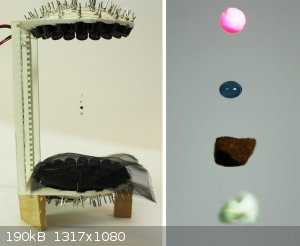
asier.marzo - 19-8-2017 at 08:21
Acoustic Levitation is the base for experiments such as Raman spectroscopy of levitated samples, crystallisation in mid-air or study of tiny organisms
in micro-gravity.
If anybody wants to have an acoustic levitator at home, I made a tutorial to build it for less than 70$.
www.acousticlevitator.com

Twospoons - 19-8-2017 at 15:02
Your webpage just got bookmarked in my 'Random cool stuff' folder. Damn you! Now I have yet another project on my bucket list.
ficolas - 19-8-2017 at 16:45
That looks really cool!
Sorry for the offtopic question but, you have a website whose only purpose currently is redirecting to the instructable?
Morgan - 19-8-2017 at 17:11
I wonder if you put some drops of alcohol in the levitator and lit them on fire if they would burn in unusual ways as the air currents affected them -
would they burn briskly or flameout I wonder? If they survived you could make different colored flaming drops.
If you could put an acoustic shell around them somehow emulating a bottle using a larger device, you could maybe create pulsating combustion, a long
shot of great complexity to be sure, but the thought crossed my mind, using air to form a walled cylinder. The pulses of air could even pump the
reaction or build feedback.
https://www.youtube.com/watch?v=hLw5AXBeAVs#t=19s
https://www.nature.com/articles/ncomms5316
[Edited on 20-8-2017 by Morgan]
Harristotle - 19-8-2017 at 17:30
I wonder if it is possible to set a little bead of gallium spinning in it, and then very carefully measure the magnetic field that produced. It would
be a really cool demonstration of our current theories of why our earth is magnetised.
Thank you so much for sharing. I have just emailed alibaba and have this marked as a next holiday project.
Cheers,
H.
Metacelsus - 19-8-2017 at 19:18
For that experiment, I suspect that any observed effects would be mainly caused by Earth's magnetic field. But it's worth a try.
Harristotle - 19-8-2017 at 22:09
Possibly Metacelsus, but I think the way you'd do it would be to set the bead spinning and compare the time it took to stop to one with a wire next to
it (ie, induced eddy currents). I doubt (like you I suspect) that you would see anything with a Gauss meter. Worth trying with that too though.
Sulaiman - 20-8-2017 at 00:00
A very nice project ... well done !
I could not use this as it would scare the bats out of my lab,
is it safe for your hearing ?
